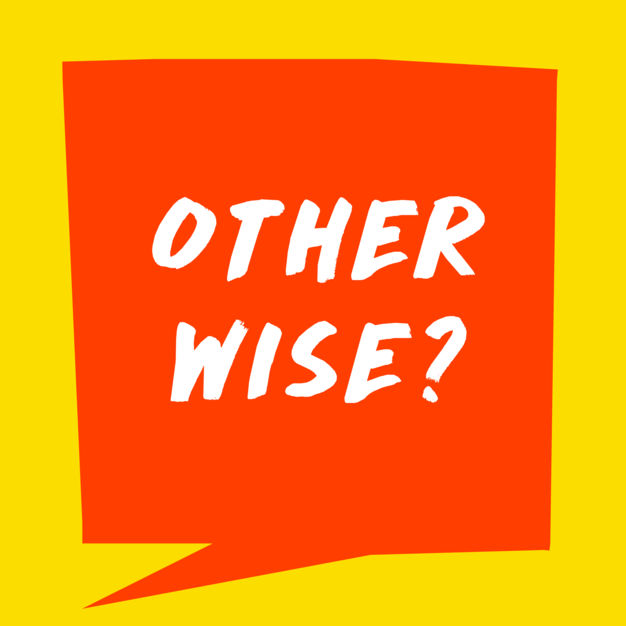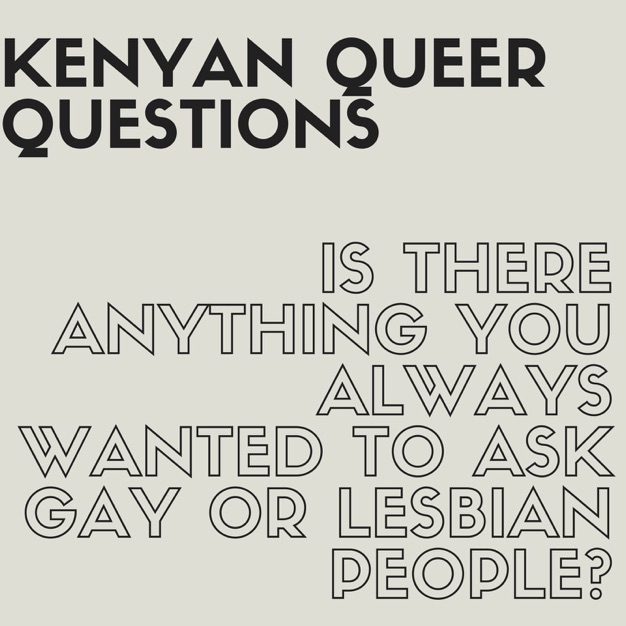
Otherwise?
Brenda Wambui
Otherwise is a weekly show that explores Kenyan current affairs issues as chosen by you. Visit our site at www.otherwisepodcast.com
- 13 minutes 53 secondsEpisode 115: A Letter To You
Hello friends! This episode is a dedication to you, who has walked this journey with me and my team for the last three years of creating Otherwise?! I am off to graduate school (The London School of Economics and Political Science) for a Masters in Public Policy and Administration, and I wanted to do one last episode before I left! :)
This episode answers the questions many of you have asked me since the inception of Otherwise?. Thank you so much for coming on this journey with me. We will be taking a break while I pursue my graduate studies, but we will be back when I'm done; bigger, better, and bolder. Kwaheri ya kuonana!
19 September 2019, 9:00 am - 36 minutes 22 secondsEpisode 114: Towards Universal Health Coverage
The Constitution in Article 43, sub-article 1 (a) states that “Every person has the right to the highest attainable standard of health, which includes the right to healthcare services, including reproductive healthcare”. Article 43 sub-article 2 also states that a person shall not be denied emergency medical treatment. The Jubilee government, as part of its Big Four Agenda, plans to roll out universal health coverage to all Kenyans by 2022, guaranteeing quality and affordable healthcare to all Kenyans. In the 2018/2019 budget, universal health coverage received a provision KES 2.5 billion.
The government plans to reconfigure the National Hospital Insurance Fund (NHIF) and reform the governance of private insurance companies. They also plan to have 100% of the poor covered by government, 9 million people covered by KES 32 billion formal member contributions, 12 million people covered by KES 28 billion informal member contributions, and a 50% decrease in out of pocket medical expenses.
We're joined by Dr. Amakove Wala, Programme Director - Health Systems Strengthening at Amref in Kenya, to talk about how we can achieve universal health coverage in Kenya.
Resources
Constitution of Kenya - Article 43: Economic and social rights
Big Four Agenda at core of Kenya spending, to spur economic growth
Towards Universal Health Coverage in Kenya: Are We On The Right Path?
County Governments At The Centre of Achieving Universal Health Care
Universal Health Care As Inspired By The Kenya Vision 2030
President Uhuru launches Universal Health Coverage Pilot Program Nairobi, (KENYA) December 13, 2018
How Kenya can attain universal health care
Universal Health Coverage: What you need to know
Universal Health Coverage Advocacy Guide
Linda Mama, Boresha Jamii: Implementation Manual for Programme Managers
Only 20% Kenyans have medical cover
Start of a new era of health care in Makueni
County Universal Social Protection Coverage for All: A Case Study of Makueni County, Kenya
What makes Makaueni's Sh 500-a year universal Health Care Programme tick
How to achieve universal health coverage? Focus on primary care
Episode 70: Financing the Kenyan Government
Episode 105: Social Protection in Kenya
12 September 2019, 9:00 am - 43 minutes 50 secondsEpisode 113: Human - Wildlife Conflict in Kenya
Human-wildlife conflict is a growing problem in Kenya today, and it has a huge negative impact on both human and wildlife populations. It happens when there is close interaction between wild animals and human beings, which leads to injury, death, predation and transmission of diseases. In February 2019, Kenya Wildlife Services (KWS) issued a notice to the public that the dry spell being experienced in most parts of the country was displacing wildlife from their traditional habitats in search of pasture and water. This had increased conflict as the wildlife came into contact with the public and human activities. They said that as the dry spell progressed, the risk of human wildlife conflict was expected to increase until the country received the long rains. Areas that have experienced increased incidence of human wildlife conflict were in Narok, Taita Taveta, Laikipia, Kajiado, Meru, Mau, Marsabit, Lamu and the Mt. Kenya region. We can assume that such warnings will become more frequent in coming years.
We’re joined by Susanna Maingi, a research scientist and wildlife ecologist with expertise in human-wildlife conflict, antipoaching and conservation outreach, to discuss the increasing cases of human-wildlife conflict in Kenya. Press play!
Resources
KENYA’S ORIGINAL SIN: Root causes of rising human-wildlife conflicts
Characteristics of Human-Wildlife Conflicts in Kenya: Examples of Tsavo and Maasai Mara Regions
77 people killed in human-wildlife conflicts in 2018: Balala
Alert on Increased Incidence of Human - Wildlife Conflict
Collapse of Wildlife migratory corridors as 100 mapped areas threatened
KWS says SGR affecting wildlife movement in Tsavo
Human-wildlife payment claims hit Sh15bn in last 5 years: PS
Human-Wildlife Conflicts and compensation for losses in Kenya
Why wildlife is critical for human existence
Human–Wildlife Conflict and Coexistence
Illegal Hunting and the Bushmeat Trade in Savanna Africa
KWS unearths illegal bushmeat trade
Report Of The Taskforce On Consumptive Wildlife Utilization in Kenya
The ugly truth about wildlife conservation in Kenya
The 2017 Shooting of Kuki Gallmann and the Politics of Conservation in Northern Kenya
How Conservation Became Colonialism
When WWF's conservation looks like colonialism, it's time for a new approach
A Leaked Report Shows WWF Was Warned Years Ago Of “Frightening” Abuses
Conservation's Biggest Challenge? The Legacy of Colonialism (Op-Ed)
Is Conservation a New Form of Colonialism?
Why are we not seeing many black faces in conservation?
Saving the world's wildlife is not just "a white person thing"
Exploring the Hidden Costs of Human–Wildlife Conflict in Northern Kenya
Public land, historical land injustices and the new Constitution
Invasive alien species in Kenya: status and management
Invasive alien species in Kenya (PDF)
Episode 24: Drought Begins With You
Episode 65: The Oil in Turkana
Episode 66: The Politics of Food in Nairobi
Episode 78: Public Finance and the Right to Food [Part 1]
Episode 79: Public Finance and the Right to Food [Part 2]
5 September 2019, 2:16 pm - 30 minutes 38 secondsEpisode 112: Consumer Protection in Kenya
The Constitution of Kenya (2010) in Article 46 gives consumers the right - to goods and services of reasonable quality; to the information necessary for them to gain full benefit from goods and services; to the protection of their health, safety, and economic interests; and to compensation for loss or injury arising from defects in goods or services. It states that parliament shall enact legislation to provide for consumer protection and for fair, honest and decent advertising (which is the Consumer Protection Act, 2012). It applies to goods and services offered by public entities or private persons.
We’re joined by Nzilani Mweu, founder of Rilani Advocates, to talk about consumer protection in Kenya. Press play!
Resources
Constitution of Kenya (2010) - Article 46
The Consumer Protection Act (2012)
The Competition Authority of Kenya
Kenya Information and Communications (Consumer Protection) Regulations, 2010.
Consumer protection diagnostic study – Kenya
Consumer Protection Law in Kenya
Protecting Consumers Means Thinking Like Consumers
Insurance Regulatory Authority - Consumer Protection
Central Bank of Kenya: Guidelines on Consumer Protection
It’s Time to Change the Equation on Consumer Protection
Financial consumer protection in Kenya: Key research findings and policy recommendations
Intersections between Intellectual Property, Consumer Protection and Competition Law in Kenya
Printing Out The Privacy Policies Of Facebook, Snap, And Others
State not committed to protecting consumer rights
Competition enforcement and consumer protection in a digital economy
29 August 2019, 7:47 am - 28 minutes 42 secondsEpisode 111: Women and Public Transport
In a survey carried out by Women’s Empowerment Link (WEL) in 2015, in the wake of the #MyDressMyChoice protest in 2014, it was found that 54% of women had experienced gender based violence (physical, sexual or psychological harm) while using public transport. The women shared that they been harassed, with the abuse ranging from derogatory comments to rape. Many witnessed female passengers being stripped naked, but the female survivors neither received any help nor reported the violation, and they reported a culture of silence held up by both male and female passengers. We also have a Geopoll survey from 2016 that highlighted that at least 46% of women in Kenya have been harassed by matatu crews.
We’re joined by Mary Mwangi, Programs Manager at Flone Initiative, to discuss the relationship between women and public transport.
Resources
Eastern Africa Women in Transportation Conference Report
How to Ease Women’s Fear of Transportation Environments: Case Studies and Best Practices
Gender in Public Transportation: A Perspective of Women Users of Public Transportation
Approaches for Gender Responsive Urban Mobility
Women and Urban Transport: Draft Policy [India]
Safety In Kenya’s Public Transport Vehicles (Matatu)
Women and transportation in East Africa
Women are changing the narrative in East Africa’s public transport sector
Report on Mobility of Care Assessment of Nairobi’s Public Minibus Transport Services
Report on Gender Equity Assessment of Nairobi’s Public Minibus Transport Services
Why your Public Transportation Sucks - Patriot Act with Hasan Minhaj
2019 Women and Transport Africa Conference
Tumi’s 5 Principles to Empower Women in Transport
22 August 2019, 2:05 pm - 51 minutes 54 secondsEpisode 110: Non-Communicable Diseases
The conversation on cancer and other non-communicable diseases has taken centre stage after the death of high profile Kenyans in recent weeks – Safaricom CEO Bob Collymore, Bomet Governor Joyce Laboso, and Kibra MP Ken Okoth. According to the Ministry of Health, Kenya in undergoing an epidemiological transition marked by a decline in morbidity and mortality due to communicable conditions, and an increase in the burden of non-communicable diseases (NCDs), which include diseases such as diabetes, cancers, cardiovascular diseases and chronic respiratory infections.
We’re joined by Dr. Laura Muambayi, a medical doctor with experience treating NCDs, as well as a primary healthcare giver, to discuss non-communicable diseases and their health implications in Kenya.
Resources
Kenya National Strategy for the Prevention and Control of Non-Communicable Diseases (2015 - 2020)
Lifestyle Diseases - An Increasing Cause Of Health Loss (Policy Brief)
Kenya Case Study: NCD Situation
Analysis of Non-Communicable Disease Prevention Policies in Kenya
Noncommunicable diseases: Fact Sheet (WHO)
Noncommunicable diseases country profiles 2018
National Cancer Screening Guidelines
National Guidelines for Cancer Management
Why many Kenyans are dying of cancer
Woman with breast cancer commits suicide in Naivasha
In East Africa, a cancer diagnosis means a death sentence
Pancreatic tumour fastest-growing cause of Kenya’s cancer deaths
IDF Diabetes Atlas - 8th Edition
Taking Diabetes to Heart - Report
Diabetes and Cardiovascular Disease - executive summary
Cost-effective solutions for the prevention of type 2 diabetes
Kenya National Diabetes Strategy (2010 - 2015)
Kenya faces rising burden of diabetes
Cases of diabetes have doubled in Kenya, warn experts
How the Sugar Industry Shifted Blame to Fat
How Big Business Got Brazil Hooked on Junk Food
Kenya National Guidelines for Cardiovascular Diseases Management
The emerging problem of coronary heart disease in Kenya
Ignorance fueling spread of heart diseases in Kenya
The danger that rheumatic heart disease poses in Kenya
Kenyans at risk of heart disease due to unhealthy lifestyles
Addressing NCDs to Fast-Track Achievement of Universal Health Coverage
Episode 10: Dereva, Chunga Maisha!
Episode 82: Debunking Mental Health Myths
15 August 2019, 12:42 pm - 1 hour 3 minutesEpisode 109: Kenya's Cultural Heritage
This week, we’re joined by Tayiana Chao, a digital heritage specialist and digital humanities scholar, of African Digital Heritage, the Museum of British Colonialism, Save the Railway and Skills 4 Culture to discuss the importance of having a digital cultural heritage for the African continent. What is the current situation in Kenya when it comes to cultural heritage? Why is it important to have conversations about cultural heritage in Kenya, especially at this moment? How do we ensure that the collection, curation, conservation, exhibition and marketing of our cultural heritage centres Kenyans?
What role does technology have to play in our archiving, exploring and understanding our cultural heritage? What gaps currently exist in terms of the skills required in this sector? What gaps exist in the collection, curation, conservation, exhibition and marketing of our heritage? How can we bridge these gaps? What role will cultural heritage will play in the Kenyan socio-political experience in the coming years? Press play to find out!
Resources
National Museums and Heritage Act (2006)
Kenya National Archives and Documentation Service
Kenya National Library Service
Mau Mau Detention Camp - Field Work
International Inventories Program
Grand history of the lunatic express
Museums are hiding their imperial pasts – which is why my tours are needed
Museums and Empire: Natural History, Human Cultures and Colonial Identities
Museums have long overlooked the violence of empire
Operation Legacy’: Britain’s Destruction and Concealment of Colonial Records Worldwide
Revealed: the bonfire of papers at the end of Empire
Britain destroyed records of colonial crimes
Foreign Office hoarding 1m historic files in secret archive
Sins of colonialists lay concealed for decades in secret archive
Mau Mau torture claim Kenyans win right to sue British government
Kenyan torture victims give evidence in high court compensation case
Kenya: UK expresses regret over abuse as Mau Mau promised payout
Kenyan Mau Mau victims in talks with UK government over legal settlement
The Mau Mau may rewrite the history of the British empire
Britain's Gulag : The Brutal End of Empire in Kenya
The house at the end of history: The little city gem that is the Murumbi Gallery
Ethical Issues In Digitization Of Cultural Heritage
Digitization of Cultural Heritage
Digitisation of Cultural Heritage
8 August 2019, 1:27 pm - 14 minutes 56 secondsEpisode 108: Otherwise? Q&A
This week, we're throwing it back to the old school format, where I take topic suggestions from the pod's community and address them in around 15 minutes. The first question is on foreign investors in Kenya. Should we set stricter criteria to attract quality investors and protect our SMEs? The second question asks what we as citizens can do to fight the Huduma Bill, and the final one asks about Mike Sonko’s behaviour at Ken Okoth’s funeral, and his blatant admission of guilt when he said that he nominated the late MP’s alleged second wife to the Nairobi County Assembly as an MCA. If this is true, what redress can we seek as Kenyans to stop this nonsense? Press play to find out!
Resources
World Investment Report (2019)
Ease of Doing Business Rankings (2019)
Foreign Investment Survey Report 2018
The Investment Promotion Act (2004)
2016 Micro, Small and Medium Enterprises (MSME) Survey Basic Report
Cheap imports, high costs: Why many businesses are closing shop
StanChart branch closure signals banking job losses
Deacons blames tough business environment for Sh180 mn loss
No healthcare, voting without Huduma Namba, Bill proposes
Parliamentary dictatorship a frontal assault on democracy
Episode 49: Women and Youth in Kenyan Politics
Episode 62: Tax Justice in Kenya
Episode 68: Women and the 2017 Elections
Episode 80: The Two-Thirds Gender Principle
Episode 85: Persons of Interest
Episode 90: On Femicide and Women at the Frontline
Episode 99: Manufacturing Prosperity
1 August 2019, 9:00 am - 40 minutes 17 secondsEpisode 107: Food Safety in Kenya
On July 14th 2019, NTV aired a feature titled Red Alert, which revealed that Kenyan supermarkets and retail outlets were using sodium metabisulfite to increase the shelf life of meat products by making them look fresher for longer, so as to prevent losses. They were also found to repackage these products and change the dates so as to dupe their customers into buying these products past their sell-by date. The conversation that arose after was intense, pointing out that supermarkets were using excess quantities of the compound, without disclosing it to consumers, which was exacerbated by changing the dates on products to deceive customers.
This is not the first time we have had widespread panic and anxiety over food in Kenya. We have had reports of sukuma wiki and spinach being grown next to sewers and being toxic and containing heavy metals, water containing microplastics, chicken being fattened using antibiotics, formalin being used to preserve meat, maize with aflatoxin, sugar containing mercury, and fruits being ripened using calcium carbide. This is in addition to pesticide use in farm products that elicits the same concerns. We’re joined by Wanjiru Kamau, an agricultural and environmental policy expert, to discuss food safety in general in Kenya.
Resources
The Kenya Food and Drugs Authority Bill (2019)
Kenya National Strategy for the Prevention and Control of Non-Communicable Diseases (2015 - 2020)
Kenya Plant Health Inspectorate Service (KEPHIS)
Pest Control Products Board (PCPB)
Dietary risk factors for non-communicable diseases in Kenya: findings of the STEPS survey, 2015
Food safety and quality management in Kenya: An overview of the roles played by various stakeholders
Food Safety in Kenya: Focus on fruits and vegetables
SBS Senior Lecturer Publishes Case Study on Food Safety Concerns in Kenya
Why food safety is a major national issue
Lifestyle Diseases: An Increasing Cause Of Health Loss
Heavy Metal Concentration in Vegetables Grown around Dumpsites in Nairobi City County, Kenya
Coca-Cola admits presence of plastic in Dasani
Antibiotics in meat: why Kenya needs to do more
Keep birds free from antibiotics, use supplements
Kenya's 'contaminated sugar' row: What we know
Report reveals seized sugar contains Mercury
Tests show dangerous levels of toxins in foods sold in Nairobi
Could your fruit vendor be selling you poison?
Experts poke holes in proposed food and drugs law
How safe is your food? Be careful what you eat
Conversation on food safety is long overdue
Study warns of highly contaminated fruits,vegetables in open markets and supermarkets
The local food revolution in Brazil's schools
Learning from Brazil’s Food and Nutrition Security Policies
25 July 2019, 1:08 pm - 37 minutes 31 secondsEpisode 106: How Do We Fix Sports in Kenya?
On 27th June 2019, Kenya beat Tanzania 3-2 in the 2019 Africa Cup of Nations (AFCON), moving us to third place in Group C, right behind Algeria and Senegal. This renewed the conversation around sports reform in Kenya. This is the first time Kenya has qualified for AFCON since 2004. We're joined by Ng'arua Kamuya, a lawyer, advocate of the High Court of Kenya and sports pundit, for a fun chat on what we can do to reform sports in Kenya. Press play!
Resources
27 June 2019, 9:00 am - 47 minutes 22 secondsEpisode 105: Social Protection in Kenya
According to Kenya's Social Protection Policy, poverty, disease, and ignorance were identified at the time of independence in 1963 as the critical challenges facing the new nation of Kenya. While some degree of success has been achieved in the area of education, progress in reducing poverty and providing healthcare has barely been made. 56 years after independence, “poverty and vulnerability remain major challenges, with almost one in every two Kenyans trapped in a long-term, chronic and inter-generational cycle of poverty."
Our Constitution in Article 43 guarantees all Kenyans their economic, social, and cultural rights. It asserts the "right for every person...to social security and binds the state to provide appropriate social security to persons who are unable to support themselves and their dependents." This right is closely linked to other social protection rights, including the right to healthcare, human dignity, reasonable working conditions, and access to justice. Article 21 establishes the progressive realization of social and economic rights and obligates the state to "observe, respect, protect, promote, and fulfill the rights and fundamental freedoms in the Bill of Rights.”
We’re joined by Pauline Vata, Executive Director of Hakijamii Trust, to discuss social protection in Kenya.
Resources
Kenya National Social Protection Policy (2012)
Article 43, Constitution of Kenya (2010)
National Social Security Fund Act (2013)
National Hospital Insurance Fund Act (2013)
Analytical Review of the Pension System in Kenya
Social security reforms in Kenya: Towards a workerist or a citizenship-based system?
Policy Brief on National Hospital Insurance Fund (NHIF)
NHIF Strategic Plan 2014 - 2018: Sustainable Financing Towards Universal Health Coverage in Kenya
PARTICIPATION OF VULNERABLE POPULATIONS IN THEIR OWN PROGRAMMES: THE CASH TRANSFERS IN KENYA
Political Economy of Cash Transfers In Kenya
Kenya’s Social Cash Transfer Program
From Evidence to Action: The Story of Cash Transfers and Impact Evaluation in Sub-Saharan Africa
The Short-term Impact of Unconditional Cash Transfers to the Poor: Experimental Evidence from Kenya
The Long-Term Impact of Unconditional Cash Transfers: Experimental Evidence from Kenya.
Income Changes and Intimate Partner Violence: Evidence from Unconditional Cash Transfers in Kenya
Scaling up Cash Transfer Programmes in Kenya
20 June 2019, 11:20 am - More Episodes? Get the App
Your feedback is valuable to us. Should you encounter any bugs, glitches, lack of functionality or other problems, please email us on [email protected] or join Moon.FM Telegram Group where you can talk directly to the dev team who are happy to answer any queries.
 Kenyan Queer Questions
Kenyan Queer Questions
 Afracanah
Afracanah
 Omenerds Podcast
Omenerds Podcast
 Nipe Story
Nipe Story